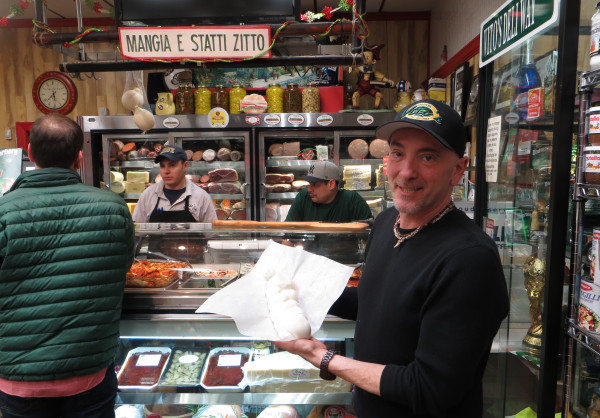
MUTZ IS ALL YOU KNEAD — Hoboken Italian Delis Always Please With the Cheese
THIS STORY IS FROM 2016.
For updated information on HFA’s annual MutzFest, CLICK HERE.
********************************************************************
(ABOVE: Peter Biancamano — M&P Biancamano Deli)
So… whutz a mutz, you ask?
Welcome to Hoboken—you’re obviously new here.
A specialty of southern Italian cuisine, mozzarella is a type of semi-soft cheese found in basically everything, from pizza to salads to sandwiches.
Here in New Jersey, however, what it is NOT, is “matzoh-rella.” That’s the kind of cheese you find further inland, on your Pizza Hut/Domino’s/Papa John’s slice.
Here in New Jersey, we have our own language. Why? Because $*@% you—that’s why.
Of course there is a slightly more cerebral explanation. As Italian immigrants made their way across the Atlantic to America, most of the boats from southern Italy came to New York. From there, the culture certainly permeated throughout the continent, but remained solidly concentrated in the greater New York metropolitan area. New Jersey is within that area, and between World War I and World War II, Hoboken’s chief ethnic group became Italian-American immigrants. To this day, we’re still reaping the gastronomic benefits of that demographic shift.
Over the years the use of the Italian language faded, eventually supplanted by a distinct New Jersey dialect—one that still had firm roots in its southern Italian heritage, yet had been mangled by every mush-mouthed Irish kid who had walked into a deli and tried to order some cheese.
Mozzarella comes from the Italian word mozzare, which means “to cut off”—part of the cheese-making process. In southern Italy, the dialect emphasized the “muzza” syllable. Over time, New Jerseyans cut off the “a” to create “muzzarell,” in some cases even garbled it to become “muzzadell” (because we get it at a deli, maybe? Who knows…), then finally chopped it down and sharpened it into “MUTZ.”
Now that we know how the word was made, let’s focus on what’s really important.
THE BIG CHEESE
Peter Biancamano’s family emigrated from Naples to New Jersey. M&P Biancamano Deli opened at 1116 Washington Street in 1981, celebrating its 35th anniversary this year.
“I keep doing the same thing,” says Biancamano. “I’m not changing anything.”
Mutz is made from curd, and kneaded by hand to take its semisoft form.
“You feel it in your hands,” says Biancamano. “It’s all about working it. It’s not a trick—it’s just timing.”
Vito Buzzerio, of Vito’s Deli (806 Washington Street) agrees. “I’ve been making mutz every day since I was 14,” he says. “I was born to make it—I never get tired of it.”
Vito’s has been around since 1986, becoming one of the most celebrated sandwich shops here in town—which is no small feat, considering the competition. Throughout that time, however, only a handful of people have been entrusted with the craft.
“I’ll bring some mutz home, and you can tell the difference who made it,” says Vito. “It’s all about the technique—the water temperature, the amount used, the feel.”
Vito’s goes through roughly 800 pounds of mutz every week. Biancamano is right there with him in terms of output. Considering the amount of Italian delis making fresh mutz on a daily basis within the one square mile that is Hoboken, it’s truly remarkable.
“We go through about 3-4 curds a day,” says Danny Losurdo, who has worked alongside his brother Nick at Losurdo Brothers / Tony’s Italian Bakery & Deli (410 Second Street) since 1975. “Curd is curd—you gotta know how to work it.”
We seem to have a consensus there.
“Fresh mutz is best served at room temperature—about 70 degrees,” says Biancamano. “You just leave it in water on the kitchen counter, and it’s good for 24 hours.” That’s fine if you’re in Hoboken—never less than five blocks from a source of world-class fresh mutz. If you’re bringing mutz home to the family, in a pinch you can take steps to keep it as fresh as possible.
“Some people freeze it,” says Biancamano. “You simply defrost it, then revive it in a bit of hot water and it comes back to life.”
Then there are the variants—fresh mutz, salted, unsalted, treccia, smoked mutz, flavored mutz, bocconcini—the culinary cornucopia goes on and on…
MUTZFEST
If you want to have a polite conversation in Hoboken, there are three topics you tend to avoid—religion, politics and mutz. But given our city’s prolific mutz production capabilities, a showdown was inevitable.
Everybody has their favorite, but when it comes to actually crowning the “Best Mutz in Hoboken,” it can get a little fierce, as bragging rights in this town tend to go a long way.
With this year marking the fourth annual event, Hoboken Mutzfest raises funds and awareness for the Hoboken Family Alliance (HFA)—a civic organization advocating family-friendly initiatives through philanthropy and events for underprivileged families and those with disabilities.
One does not simply walk into Mutzfest. Year after year the spacious Elk’s Lodge (1005 Washington Street) is packed to the rafters, with sold-out crowds devouring a stunning array of mutz presentations. With (literally) a ton of cheese curd donated by Polly-O, each deli starts from scratch and gets to work on their craft.
“We have a very dedicated staff,” says Vito. “It’s a tall task that takes a lot of time, but we still have the passion for it.”
In the past, delis would compete for the crown in a variety of categories—Best Sandwich, Critic’s Choice, People’s Choice, and the coveted Best Overall. But this year, the format is a little different.
 “There’s no judging,” says Theresa Howard, HFA’s Director – Children With Special Needs. “We figured we’d come together as a community and just celebrate mutz in general.”
“There’s no judging,” says Theresa Howard, HFA’s Director – Children With Special Needs. “We figured we’d come together as a community and just celebrate mutz in general.”
And why not? When you have so much of a good thing, there’s no need to squabble over which is better.
“Everybody has a good time,” says Danny Losurdo. “That’s what we’re there for.”
Losurdo is a genuine proponent of the event from a philanthropic perspective, and he puts his money where his mutz is.
“My daughter has been involved with Hoboken Family Alliance—she worked the bicycle camp they had where everyone learned how to ride a bike,” says Losurdo. “They do some great things.”
MUTZCRAFT
The respect among Hoboken’s mutzmakers is certainly palpable. With such a demand, everyone gets to mozzare their own chunk of the curd.
Just ask the crew at Tony Boloney’s—the relative upstarts who became the new kids on the block about a year ago. With a deep and dizzying selection of fresh, handmade mutz—in flavors like pesto, truffle, Indian Tikka or Crabby—they’re quick to give a nod to their established neighbors.
“We do a different spin on things here,” said owner Mike Hauke in a recent interview with hMAG. “But we still love Luca Brasi’s for a traditional Italian sub.”
Meanwhile Biancamano’s speaks highly of Vito’s, Vito’s speaks highly of Biancamano’s, and so on—Luca’s, Fran’s, Sasso’s, Lisa’s, Margherita’s, Rosticeria di Gigi, Fiore’s, etc. Everyone seems to know that they’re at the pinnacle of their craft.
“I don’t talk bad about anybody,” says Losurdo, “I try to get along with everybody, because there’s a lot of great mutz in this town. We all just do our thing, and let you be the judge.”
And with that, everybody wins.




 Previous Article
Previous Article Next Article
Next Article READ ALL ABOUT IT: The Hoboken Public Library Celebrates 125 Years of Greatness and Community Leadership
READ ALL ABOUT IT: The Hoboken Public Library Celebrates 125 Years of Greatness and Community Leadership  FRIDAYS ARE FOR FRANK: Chairman of the Board & the Duke of Edinburgh
FRIDAYS ARE FOR FRANK: Chairman of the Board & the Duke of Edinburgh  FRIDAYS ARE FOR FRANK: “Daybreak”
FRIDAYS ARE FOR FRANK: “Daybreak”  FRIDAYS ARE FOR FRANK: “My Kind Of Town” (Jeopardy! Edition)
FRIDAYS ARE FOR FRANK: “My Kind Of Town” (Jeopardy! Edition)  NUTZ FOR MUTZ: Hoboken Mutzfest 2019 Salutes the Big Cheese—SUNDAY, JAN 27th
NUTZ FOR MUTZ: Hoboken Mutzfest 2019 Salutes the Big Cheese—SUNDAY, JAN 27th  FRIDAYS ARE FOR FRANK: “That’s Life”
FRIDAYS ARE FOR FRANK: “That’s Life”  FRIDAYS ARE FOR FRANK: “The September of My Years”
FRIDAYS ARE FOR FRANK: “The September of My Years”  Meat & Greet: Piccolo’s – “Famous for Cheesesteaks” for 60 Years
Meat & Greet: Piccolo’s – “Famous for Cheesesteaks” for 60 Years